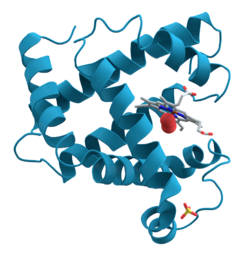Biology:CDC42EP1
From HandWiki
 Generic protein structure example |
Cdc42 effector protein 1 is a protein that in humans is encoded by the CDC42EP1 gene.[1][2][3]
CDC42 is a member of the Rho GTPase family that regulates multiple cellular activities, including actin polymerization. The protein encoded by this gene is a CDC42 binding protein that mediates actin cytoskeleton reorganization at the plasma membrane. The encoded protein, which is secreted, is primarily found in bone marrow. Two transcript variants encoding different isoforms have been found for this gene.[3]
References
- ↑ "cDNA cloning and molecular characterization of MSE55, a novel human serum constituent protein that displays bone marrow stromal/endothelial cell-specific expression". J Biol Chem 267 (20): 13986–92. Aug 1992. doi:10.1016/S0021-9258(19)49667-1. PMID 1629197.
- ↑ "MSE55, a Cdc42 effector protein, induces long cellular extensions in fibroblasts". Proc Natl Acad Sci U S A 96 (16): 9083–8. Sep 1999. doi:10.1073/pnas.96.16.9083. PMID 10430899. Bibcode: 1999PNAS...96.9083B.
- ↑ 3.0 3.1 "Entrez Gene: CDC42EP1 CDC42 effector protein (Rho GTPase binding) 1". https://www.ncbi.nlm.nih.gov/sites/entrez?Db=gene&Cmd=ShowDetailView&TermToSearch=11135.
External links
- Human CDC42EP1 genome location and CDC42EP1 gene details page in the UCSC Genome Browser.
Further reading
- "The Borgs, a New Family of Cdc42 and TC10 GTPase-Interacting Proteins". Mol. Cell. Biol. 19 (10): 6585–97. 2000. doi:10.1128/MCB.19.10.6585. PMID 10490598.
- Dunham I; Shimizu N; Roe BA et al. (1999). "The DNA sequence of human chromosome 22". Nature 402 (6761): 489–95. doi:10.1038/990031. PMID 10591208. Bibcode: 1999Natur.402..489D.
- "A new family of Cdc42 effector proteins, CEPs, function in fibroblast and epithelial cell shape changes". J. Biol. Chem. 276 (2): 875–83. 2001. doi:10.1074/jbc.M007039200. PMID 11035016.
- Strausberg RL; Feingold EA; Grouse LH et al. (2003). "Generation and initial analysis of more than 15,000 full-length human and mouse cDNA sequences". Proc. Natl. Acad. Sci. U.S.A. 99 (26): 16899–903. doi:10.1073/pnas.242603899. PMID 12477932. Bibcode: 2002PNAS...9916899M.
- Gevaert K; Goethals M; Martens L et al. (2004). "Exploring proteomes and analyzing protein processing by mass spectrometric identification of sorted N-terminal peptides". Nat. Biotechnol. 21 (5): 566–9. doi:10.1038/nbt810. PMID 12665801.
- Ballif BA; Villén J; Beausoleil SA et al. (2005). "Phosphoproteomic analysis of the developing mouse brain". Mol. Cell. Proteomics 3 (11): 1093–101. doi:10.1074/mcp.M400085-MCP200. PMID 15345747.
- Collins JE; Wright CL; Edwards CA et al. (2005). "A genome annotation-driven approach to cloning the human ORFeome". Genome Biol. 5 (10): R84. doi:10.1186/gb-2004-5-10-r84. PMID 15461802.
- Gerhard DS; Wagner L; Feingold EA et al. (2004). "The Status, Quality, and Expansion of the NIH Full-Length cDNA Project: The Mammalian Gene Collection (MGC)". Genome Res. 14 (10B): 2121–7. doi:10.1101/gr.2596504. PMID 15489334.
- Zhang J; Zhu J; Bu X et al. (2005). "Cdc42 and RhoB Activation Are Required for Mannose Receptor-mediated Phagocytosis by Human Alveolar Macrophages". Mol. Biol. Cell 16 (2): 824–34. doi:10.1091/mbc.E04-06-0463. PMID 15574879.
- Rual JF; Venkatesan K; Hao T et al. (2005). "Towards a proteome-scale map of the human protein-protein interaction network". Nature 437 (7062): 1173–8. doi:10.1038/nature04209. PMID 16189514. Bibcode: 2005Natur.437.1173R.
- Kimura K; Wakamatsu A; Suzuki Y et al. (2006). "Diversification of transcriptional modulation: Large-scale identification and characterization of putative alternative promoters of human genes". Genome Res. 16 (1): 55–65. doi:10.1101/gr.4039406. PMID 16344560.
- Olsen JV; Blagoev B; Gnad F et al. (2006). "Global, in vivo, and site-specific phosphorylation dynamics in signaling networks". Cell 127 (3): 635–48. doi:10.1016/j.cell.2006.09.026. PMID 17081983.

